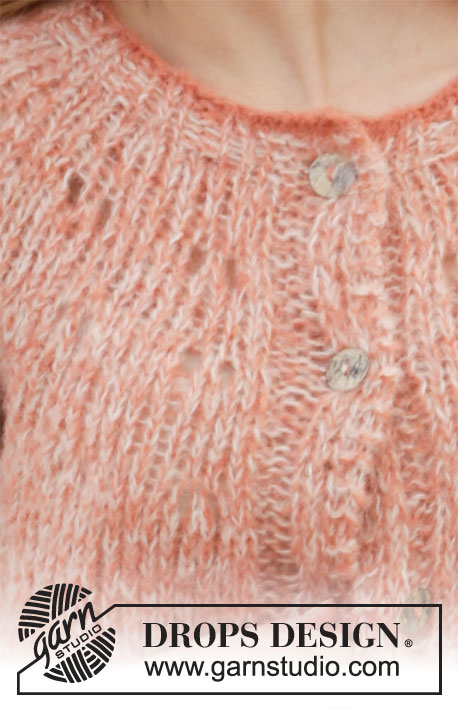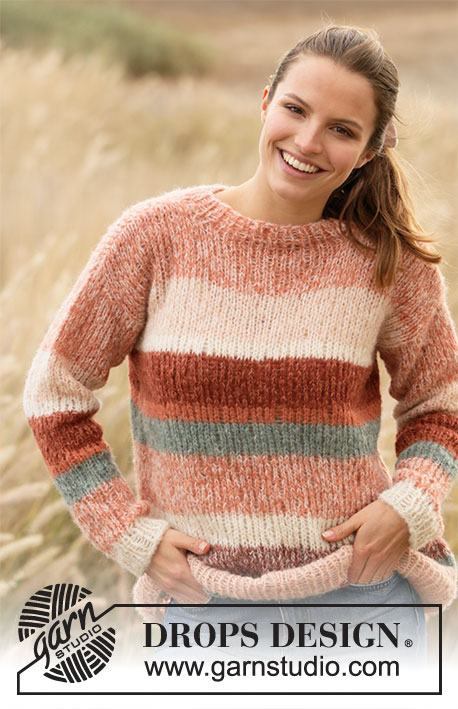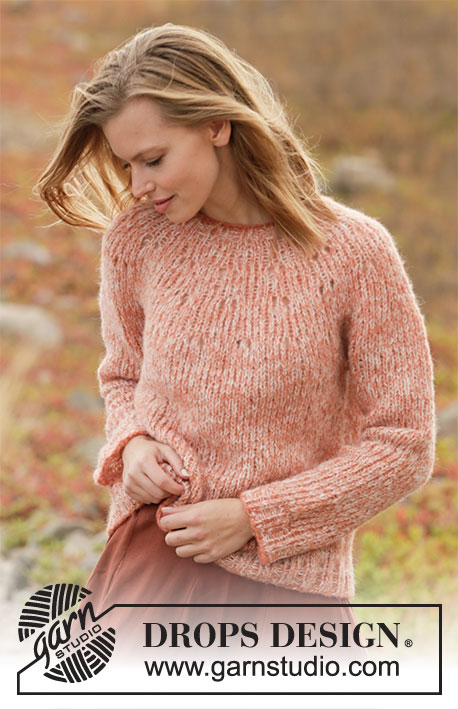Frosted Foliage Jacket |
||||||||||
 |
 |
|||||||||
Knitted jacket with round yoke in 2 strands DROPS Brushed Alpaca Silk. The piece is worked top down. Sizes S - XXXL.
DROPS 212-35 |
||||||||||
|
------------------------------------------------------- EXPLANATIONS FOR THE PATTERN: ------------------------------------------------------- PATTERN: See diagrams A.1 to A.4. The diagrams show all the rows in the pattern seen from the right side. INCREASE TIP (evenly spaced): To work out how to increase evenly, count the total number of stitches on the needle (e.g. 66 stitches) minus the bands (e.g. 12 stitches) and divide the remaining stitches by the number of increases to be made (e.g. 6) = 9. In this example, increase by making 1 yarn over after each 9th stitch and do not increase on bands. On the next row work the yarn overs twisted to avoid holes. DECREASE TIP (for sleeves): Decrease 1 stitch on each side of the marker thread as follows: Work until there are 3 stitches left before the marker thread, knit 2 together, knit 2 (marker thread sits between these 2 stitches), slip 1 stitch as if to knit, knit 1 and pass the slipped stitch over the knitted stitch. BUTTONHOLES: Work buttonholes on right band (when garment is worn). Work from the right side when there are 6 stitches left on the row as follows: Knit 2, make 1 yarn over, knit 2 together and work the last stitches. On the next row (wrong side) knit the yarn over to leave a hole. The first buttonhole is worked when the neck measures 3 cm = 1⅛". The other 5-5-6-6-6-6 buttonholes are worked with approx. 9½-10-8½-9-9½-9½ cm = 3¾"-4"-3¼"-3½"-3¾"-3¾" between each one. BINDING-OFF TIP: To avoid the bind-off edge being tight you can bind off with a larger size needle. If the edge is still tight, make 1 yarn over after approx. each 4th stitch at the same time as binding off and the yarn overs are bind off as normal stitches. ------------------------------------------------------- START THE PIECE HERE: ------------------------------------------------------- JACKET – SHORT OVERVIEW OF THE PIECE. The neck and yoke are worked back and forth with circular needle, from mid front and top down. The yoke is divided for body and sleeves and the body continued back and forth with circular needle. The sleeves are worked in the round with double pointed needles/short circular needle, top down. NECK: Cast on 66-66-70-74-74-78 stitches (including 6 band stitches on each side towards mid front) with circular needle size 6 mm = US 10 and 2 strands pale rust (= 2 strands). Purl 1 row (= wrong side). Change to 1 strand pale rust and 1 strand off-white. The next row is worked as follows from the right side: Work A.1 over the first 6 stitches (= band), * knit 2, purl 2 *, work from *-* until there are 8 stitches left on the row, knit 2 and finish with A.2 over the last 6 stitches (= band). Continue this rib for 3 cm = 1⅛" – remember the BUTTONHOLES on right band – read description above. When the rib is finished knit 1 row from the right side where you increase 6-11-12-13-18-24 stitches evenly spaced – read INCREASE TIP = 72-77-82-87-92-102 stitches. Purl 1 row from the wrong side (yarn overs are purled twisted and the bands are worked as before). Change to circular needle size 8 mm = US 11. Insert 1 marker after the band at the beginning of the row (mid front); the yoke will be measured from this marker! YOKE: Work stockinette stitch back and forth with A.1 and A.2 over the outermost 6 stitches on each side as before. REMEMBER THE KNITTING GAUGE! When the piece measures 4 cm = 1½" from the marker increase as follows: INCREASE 1: Work A.1 over the first 6 stitches, A.3 until there are 6 stitches left (= 12-13-14-15-16-18 repeats of 5 stitches), A.2 over the last 6 stitches. When A.3 has been completed in height you have increased 24-26-28-30-32-36 stitches = 96-103-110-117-124-138 stitches. Continue with stockinette stitch and 6 band stitches on each side until the piece measures 8-9-10-10-11-12 cm = 3⅛"-3½"-4"-4"-4⅜"-4¾". INCREASE 2: Work A.1 over the first 6 stitches, knit 0-1-1-2-2-0, work A.4 until there are 6-6-7-7-8-6 stitches left (= 14-15-16-17-18-21 repeats of 6 stitches), knit 0-0-1-1-2-0, work A.2 over the last 6 stitches. When A.4 has been completed in height you have increased 28-30-32-34-36-42 stitches = 124-133-142-151-160-180 stitches. Continue with stockinette stitch and 6 band stitches on each side until the piece measures 12-14-16-17-19-20 cm = 4¾"-5½"-6¼"-6¾"-7½"-8". INCREASE 3: Work A.1 over the first 6 stitches, knit 2-1-2-1-2-0, work A.4 until there are 8-6-8-6-8-6 stitches left (= 18-20-21-23-24-28 repeats of 6 stitches), knit 2-0-2-0-2-0, work A.2 over the last 6 stitches. When A.4 has been completed in height you have increased 36-40-42-46-48-56 stitches = 160-173-184-197-208-236 stitches. Continue with stockinette stitch and 6 band stitches on each side until the piece measures 18-20-22-24-26-28 cm = 7"-8"-8¾"-9½"-10¼"-11" – adjust so the last row is worked from the wrong side. Now divide the yoke for body and sleeves on the next row as follows: Work the first 27-29-30-32-34-39 stitches as before (= right front piece), place the next 32-34-37-39-42-46 stitches on 1 thread for the sleeve, cast on 6-6-8-8-8-8 new stitches on the needle (= in side under the sleeve), work 42-47-50-55-56-66 stitches as before (= back piece), place the next 32-34-37-39-42-46 stitches on 1 thread for the sleeve, cast on 6-6-8-8-8-8 new stitches on the needle (= in side under the sleeve) and work the remaining 27-29-30-32-34-39 stitches as before (= left front piece). Body and sleeves are finished separately. THE PIECE IS NOW MEASURED FROM HERE! BODY: = 108-117-126-135-140-160 stitches. Continue with 1 strand of each color (= 2 strands), stockinette stitch and 6 band stitches on each side as before. When the piece measures 30 cm = 11¾", increase 18-21-24-27-30-30 stitches evenly spaced = 126-138-150-162-170-190 stitches. Change to circular needle size 6 mm = US 10 and work rib as follows: A.1 over the first 6 stitches, * knit 2, purl 2 *, work from *-* until there are 8 stitches left, knit 2 and work, A.2 over the last 6 stitches. Continue back and forth like this until the rib measures 4 cm = 1½". Change to 2 strands pale rust. Bind off with knit over knit and purl over purl – read BINDING-OFF TIP. The jacket measures approx. 56-58-60-62-64-66 cm = 22"-22¾"-23⅝"-24⅜"-25¼"-26" from the shoulder down. SLEEVE: Place the 32-34-37-39-42-46 stitches from the thread on the one side of the piece on short circular needle size 8 mm = US 11 and knit up 1 stitch in each of the 6-6-8-8-8-8 stitches cast on under the sleeve = 38-40-45-47-50-54 stitches. Insert a marker thread in the middle of the 6-6-8-8-8-8 stitches under the sleeve. Allow the thread to follow your work onwards; it will be used when decreasing under the sleeve. Start the round at the marker thread and work stockinette stitch in the round with 1 strand of each color (= 2 strands). When the sleeve measures 4 cm = 1½" from the division in all sizes, decrease 2 stitches under the sleeve – read DECREASE TIP. Decrease like this every 6-5-3½-3½-3-2½ cm = 2⅜"-2"-1¼"-1¼"-1⅛"-⅞" a total of 6-7-9-9-10-12 times = 26-26-27-29-30-30 stitches. When the sleeve measures 40-39-37-35-34-32 cm = 15¾"-15¼"-14½"-13¾"-13⅜"-12½" (shorter measurements in larger sizes due to longer yoke) increase 2-2-5-3-6-6 stitches evenly spaced = 28-28-32-32-36-36 stitches. Change to double pointed needles size 6 mm = US 10 and work rib (= knit 2 /purl 2) for 4 cm = 1½". Change to 2 strands pale rust. Bind off with knit over knit and purl over purl – remember BINDING-OFF TIP. The sleeve measures approx. 44-43-41-39-38-36 cm = 17¼"-17"-16⅛"-15¼"-15"-14¼" from the division. Work the other sleeve in the same way. |
||||||||||
Diagram explanations |
||||||||||
|
||||||||||

|
||||||||||
|
Have you made this or any other of our designs? Tag your pictures in social media with #dropsdesign so we can see them! Do you need help with this pattern?You'll find tutorial videos, a Comments/Questions area and more by visiting the pattern on garnstudio.com. © 1982-2024 DROPS Design A/S. We reserve all rights. This document, including all its sub-sections, has copyrights. Read more about what you can do with our patterns at the bottom of each pattern on our site. |
||||||||||































































Comments / Questions (10)
Rust 27 g colour 22 dyelot 533626 , hvid 26 g colour 1 dyelot 307587 strikkefasthed passer. der er 6 g tilbage af nøgle 3 af rust og 1 meter af den hvide. og i min verden burde der være brugt mest rust .
31.10.2022 - 14:53Se tidligere spørgsmål og svar. Kan godt se der skal bruges mere rust og derfor forstår jeg ikke at jeg har brugt mindre rust indtil nu. Det 3 nøgle af hver jeg er i gang med og det hvide er opbrugt og det rust er der en del tilbage af. Har endnu 2 rust og 1 hvidt tilbage også
31.10.2022 - 13:39DROPS Design answered:
Hei Dorte. Kan du veie nøstene? Hvert nøste skal veie 25 gram. Kanskje rust veier litt mer en 25 gram og natur litt mindre enn 25 gram, eller omvendt derfor blir det den forskjellen. Kan du også opplyse hvilket partnr. disse nøstene har, så får vi dobbeltsjekke. Og gjerne hvilken strikkefasthet du får med disse 2 garnene sammen. mvh DROPS Design
31.10.2022 - 13:44Forstår hvorfor der ikke er lige mange nøgler af hver farve til alle størrelser. Kommer til at mangle 1 nøgle hvid 01. Der er tilsyneladende heller ikke lige antal meter i røde og hvide . Har 2 1/4 nøgle rød og kun 1 nøgle hvid tilbage og mangler begge ærmer og nederste rib . Har købt hos Garnius, de ville kontakte jer ang. opskriften.
30.10.2022 - 19:38DROPS Design answered:
Hei Dorte. Det strikkes litt mer av lys rust fargen enn natur (kantene på halsen, ermene og vrangbordskanten helt nederst), derfor er det 1 nøste mer av lys rust enn natur. Begge fargene / nøstene skal veie 25 gram og ha ca en løpelengde på 140 meter, men det kan forekomme litt forskjell, både at et nøste veier litt mer eller litt mindre. mvh DROPS Design
31.10.2022 - 13:01Jeg strikker str L? Jeg får ei maske mer(4) på slutten før stolpen etter siste øking enn fra starten hvor jeg strikker 3 masker etter stolpe og før første øking?? Dette gjelder 2.øking. Maskeantall er riktig!
16.01.2022 - 12:06DROPS Design answered:
Hei Janne. Ja, du vil få 1 maske mer både på 2. og 3. økning på den ene siden (den siden før du strikker stolpen, fra retten). mvh DROPS Design
18.01.2022 - 10:18Klarer ikke å forstå hvordan jeg begynner. Har legg opp og strikket første omgang. Sliter med halskant og hvordan jeg får en vrangbord i forhold til oppskriften. Får det ikke til å stemme. Hår det an å få oppskrift på genseren isteden, eventuelt en forklaring som er litt lettere å forstå. Er litt ny i dette
04.07.2021 - 15:08Bonjour. Je souhaite demander une clarification: "La taille des aiguilles est uniquement indiquée à titre indicatif. Si vous avez trop de mailles pour 10 cm, essayez avec des aiguilles plus grosses. Si vous n'avez pas assez de mailles pour 10 cm, essayez avec des aiguilles plus fines." n' est-ce pas le contraire que vous entendez dire? il se peut que je comprenne mal mais si j' ai trop de mailles il ne me faudrait pas des aiguilles plus fines et vice-versa?
21.02.2021 - 09:37DROPS Design answered:
Bonjour Mme Stefanidou, si vous avez trop de mailles pour 10 cm, c'est que vous tricotez trop serré, il vous faudra réessayer avec des aiguilles plus fines (et si vous n'avez pas assez de mailles pour 10 cm, c'est que vous tricotez plus lâche que l'échantillon, il faudra essayer avec des aiguilles plus fines). Retrouvez ici plus d'informations sur l'échantillon. Bon tricot!
22.02.2021 - 10:03Hallo! Die senkrechte Blende (Knopfleiste) rollt sich auf (am Übergang zwischen 2 rechten und 2 linken Maschen). Wie kann ich das verhindern? Vielen Dank für die Antwort! Herzliche Grüße 😊
07.02.2021 - 16:10DROPS Design answered:
Liebe Britta, Sie können die Jacke mit Stecknadeln auf einer geeigneten Unterlage spannen, anfeuchten (z.B. mit einer Sprühflasche für Blumen) und trocknen lassen, danach entfernen Sie die Stecknadeln, dann sollte sich die Blende nicht mehr rollen. :)
08.02.2021 - 10:17Jeg får ikke lastet ned oppskriften
15.07.2020 - 10:41DROPS Design answered:
Hei Anne Berit. Sjekk internett tilgangen din. Vi har ingen problemer, jakken ligger ute på våre hjemmesider. mvh DROPS design
15.07.2020 - 14:44Hei, oppskrift 212-35 står det ‘fortsett vrangborden slik i 3cm - husk knapphull’. Men i tips om knapphull står det at det lages når vrangborden er 3 cm: men da skal man jo egentlig slutte med vrangborden. Betyr det at knapphullet kommer i siste rette i vrangborden?
31.03.2020 - 15:04DROPS Design answered:
Hei Gudrun. Det står ca 3 cm, bare avpass at du får felt fra retten. God Fornøyelse!
17.04.2020 - 09:21Modelo muito bonito, vou tentar fazer, gostava tb de ter o modelo para bébé
17.01.2020 - 14:13